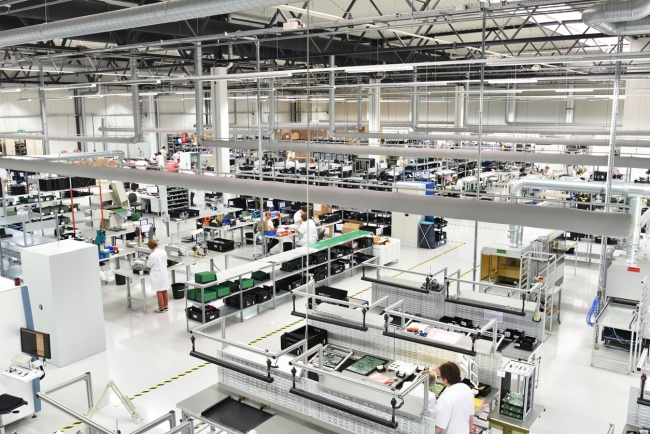5 minute read • published in partnership with Cimlogic
Insight: 10 steps to manufacturing execution system success
You know the benefits a Manufacturing Execution System (MES) can bring to all aspects of production, from quality to performance, maintenance, energy, and capacity management. But how do you justify this at board level? How can you create a compelling business case for investment in MES? Cimlogic looks at what manufacturers should be focused on as part of a smart factory journey.
MES affects the whole organisation, and any decision to implement an MES needs support from all stakeholders, from board level to process operators. Without understanding the tangible, quantifiable benefits of any new system (as well as associated timescales for ROI), it can be virtually impossible to persuade management to invest in what can be seen as an isolated IT or manufacturing project. Additionally, process owners from across the business will not support operational changes (such as those an MES might bring) if they do not see immediate, justifiable benefits. How will it make their lives easier? Why should they accept a change to the status quo?

Manufacturers who follow the right methodologies can justify their MES system investment and ensure a successful project which delivers the expected business value and ROI / Picture: Getty/iStock
How can I justify an MES investment and secure budget approval?
For a business leader initiating an MES project (regardless of functional responsibility), it’s important to understand that this is a company-wide implementation, which will only succeed if there is buy-in from all stakeholders. A clear understanding of what the project will achieve for the business, documented milestones, and measured ROI at key stages of implementation will go a long way to ensuring enterprise-wide acceptance and a successful project. So, what are the recommended 10 steps?
1 – Where are we now?
A successful project needs to start at the beginning! ie what is the company strategy, what are the medium- and long-term business goals and how do these relate to departmental operational plans. An MES needs to align to these – how will the MES support the business and departmental goals and KPIs?
2 – Select key stakeholders for the ‘MES team’
Understand current business requirements and recommendations for improvement. Use analytical methodologies such as lean tools and data analysis to further investigate opportunities and challenges, and the key KPIs.
3 – Build the business case!
How can an MES deployment support the business goals? Use the data analysis and supporting evidence to build a compelling business case, along with financial benefits for each step of a technology roadmap. eg if company goals include reducing the cost of goods, increasing capacity and ensuring regulatory compliance, the MES team need to demonstrate how these can be achieved via an MES roll-out.
4 – Set your priorities
Understanding the financial and business benefits of each step of the MES roadmap enables you to benefit from ‘quick wins’. A modular MES allows staged implementation of key functions over a period of time, ensuring ROI at each step of the technology roadmap.
5 – Speak the language
Armed with an understanding of current challenges, business requirements, the results of the analysis and a clear plan as to how MES addresses the business KPIs, it’s time for the business case presentation. The MES implementation needs to be clearly linked to achieving short-term business goals and adhering to long-term strategy. Business leaders do not want a features and functions technical MES overview; they want to know how an MES implementation will help reduce costs, increase capacity, ensure regulatory compliance etc. And by when these will be achieved! Statements such as ‘20% increase in operator efficiency in 3 months, 10% reduction in raw material costs in the next 12 months’ cannot be ignored in the budget negotiations.

Cimlogic’s RAISE process helps manufacturers navigate through the smart factory journey, ensuring alignment with critical business goals / Picture: Getty/iStock
6 – Understand the bigger picture
Your MES implementation might be one of a number of investment options under review. Be prepared to justify the benefits of MES versus other potential investments, in meeting diverse business goals and addressing future company strategy.
7 – Justify your selection
Looking beyond the next 12-18 months, what will your MES cost over its lifetime? How does it compare to alternative (initially cheaper) options? Beyond the initial licence cost, a keen understanding of total cost of ownership is crucial to gaining budget approval. Hidden costs such as consultancy, training, security, change management etc all need to be considered. Understanding all cost elements and the overall total cost of MES over its lifetime are critical to making a well-informed decision for the business.
8 – Engage the wider team
In conjunction with ‘selling’ the MES at board level, it’s important to gain buy-in for the system at all levels within the organisation. Remember to tailor the message according to the audience. How will MES make their lives easier? What department challenges will it address? What operational process changes might be needed and how will these be implemented with minimal disruption? From plant directors to shift operators, it’s vital to be able to demonstrate how a new implementation will improve their ability to meet individual and department goals or KPIs. Understand the ‘What’s in it for me?’ question. An MES implementation without endorsement from both board sponsors and plant level operatives will not succeed.
9 – Be prepared to start small
Company directors may be hesitant at committing to investment in MES without proof of ROI. The business case and analysis activity in steps 2 to 4 should allow you to identify specific functional areas, production lines or locations which could yield ‘quick wins’ from a pilot project. In these cases, ensure you accurately record base-line scenarios, existing metrics and challenges. The MES pilot project can then be used to demonstrate measurable improvements compared to the starting position. Pilot projects can be extremely powerful in securing approval for larger MES implementations. It’s hard to argue with bottom-line figures on costs savings/productivity improvements etc, when these figures are provided from the company’s own data.
10 – Publish a road map for success
Identify areas, locations, production lines etc and a timeline for implementation. The business case established in steps 3 and 4 should guide this process, with input from the MES team selected in step 2. This roadmap helps the company understand the benefits of an enterprise-wide MES roll-out, with tangible business value generated at every stage. The data from the pilot project (if applicable) can be used to support this.
Manufacturers who follow methodologies such as this are able to not only justify their MES system, but also secure ongoing engagement with the implementation at all levels of the organisation, ensuring a successful project which delivers the expected business value and ROI.
Where are you on your smart factory journey? Are you unsure where to start or how to make progress? Cimlogic’s unique RAISE™ process provides a proven methodology through upfront business analysis, solution implementation, support, and ongoing LEAN continuous improvement. All designed to efficiently support manufacturers to achieve their business goals and lower the cost to serve, whilst realising maximum business value.
Click here to learn more about how RAISE™ helps Cimlogic’s manufacturing clients navigate seamlessly through the smart factory journey, ensuring alignment with critical business goals, whilst delivering operational excellence and maximum business value.
